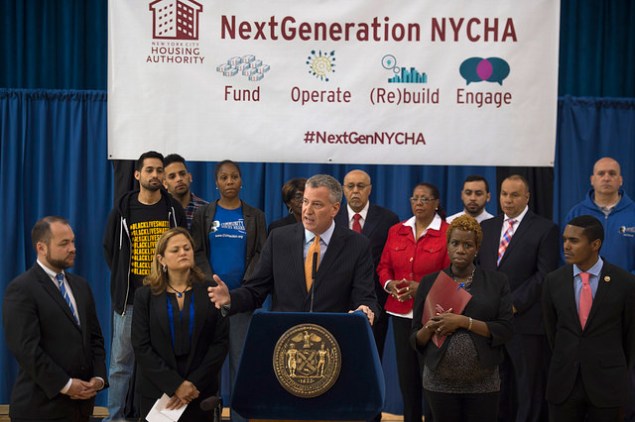
Mayor Bill de Blasio" class="company-link">Bill de Blasio unveiled today his administration’s long-awaited “NextGeneration NYCHA” plan, designed to address what he called the “worst financial crisis” in the New York City Housing Authority‘s eight-decade history—and simultaneously construct 10,000 new low-cost apartments that will count toward his ambitious affordable housing agenda.
NextGeneration NYCHA, details of which the Observer reported last month, resembles former Mayor Michael Bloomberg’s controversial “infill” plan in calling for the leasing of open space at housing authority properties to private developers to build. But Mr. de Blasio was quick to point out that, while Mr. Bloomberg’s plan would have allowed for predominantly luxury construction, most of the new buildings would be 100 percent below-market, renting at rates affordable to a family of three earning $46,000 a year or less.
“This is a very different plan than was presented in the past,” Mr. de Blasio insisted to the Observer at the James Weldon Community Center in East Harlem, emphasizing that the plan will also guarantee NYCHA residents work on the construction projects, and earmark the new revenue for work on the existing public housing buildings on the parcels. “I think this is the kind of change we have needed for a long time, and it does respond to they many things that there were concerns raised about over the last years that were missing in the previous plan.”
The mayor said his administration was still looking at where exactly to locate the new buildings, and said it would also seek to build some mixed-income development, with half the units renting at market rate. The mayor’s office projected that this housing could yield as much as $600 million over the next decade, far more than Mr. Bloomberg ever predicted for his plan, which Mr. de Blasio said was due to increasing property values.
The revenue generated will go to close NYCHA’s swelling yearly operating deficit, which is projected to hit $400 million by 2019, and its more than $16 billion backlog in needed structural, electrical and heating system work. The plan will also ease the burden on NYCHA’s books by dissolving the authority’s call center and have public housing tenants address their complaints to the general city help line, 311 or to a new MyNYCHA phone app, and move 1,000 office employees off the authority’s payroll and onto those of city agencies.
The city will pay to refurbish vacant commercial storefronts at NYCHA properties so they can be rented, and increase revenues from parking by increasing the rates paid by the 10,000 resident permit holders and by selling permits to non-residents. It will also seek to increase rent collection from the current 77 percent rate by allowing tenants to pay online, set up automatic deposit or make multiple payments in the course of a month.
NextGeneration also calls for NYCHA to finally place the 5,000 un-subsidized apartments it inherited from the city and state eight years ago onto federal Section 8 contracts.
It will also enter 1,400 units in a development in Far Rockaway, Queens into HUD’s controversial Rental Assistance Demonstration plan, which will remove the apartments from the usual federal subsidy streams and instead place them on Section 8 contracts—allowing NYCHA to mortgage the properties with private lenders and receive an array of tax breaks. The authority will place an additional 8,313 apartments in severe disrepair on Section 8 funds.
Such moves, along with infill, are seen by some as major steps toward the privatization of public housing.
In combination with several other efficiency measures and a new “Fund for Public Housing” nonprofit that will raise $300 million from philanthropists, Mr. de Blasio said that the authority would be able to make up for the loss of funds from Albany and Washington, D.C., since the 1980s and allow NYCHA to turn a surplus of more than $200 million a year.
“We realized we had to do something fundamentally different in light of this sad trend we’ve seen,” he said. “We believe there are tools we can use, and new ways and powerful ways to address these problems. This is, at this moment, the worst financial crisis in the history of NYCHA.”
Shola Olatoye, Mr. de Blasio’s NYCHA chairwoman, thanked the mayor for also baselining the $70 million the authority formerly paid to the NYPD for protection into his executive budget and for eliminating NYCHA’s $30 million annual payment in lieu of property taxes. The chairwoman, who spent months meeting with tenants ahead of the plan’s release, warned that the only alternative to NextGeneration is demolition by neglect.
“Continuing on this path is not acceptable. And if we do, we stand the potential to lose NYCHA’s 328 developments,” she said. “NYCHA must make some tough decisions, and we must change. No one knows this better than our residents.”
Bronx Councilman Ritchie Torres, chairman of the Committee on Public Housing and a NYCHA native himself, was on hand to praise the “bold plan.” He said the transitions outlined in NextGeneration will be difficult for residents and employees alike, but echoed Ms. Olatoye in maintaining that they are necessary.
“The mayor’s plan contains painful choices, and the choices are painful because there is no way of addressing a $17 billion capital need,” he said.
There was a brief break in the program when one of the residents standing on a dais behind the officials fainted while Council Speaker Melissa Mark-Viverito, in whose district the press conference took place, was speaking. The lawmakers helped escort the woman behind a curtain, and she was given a drink of
“It was not a comment on the proposal!” Mr. de Blasio jokingly assured the press afterward.

